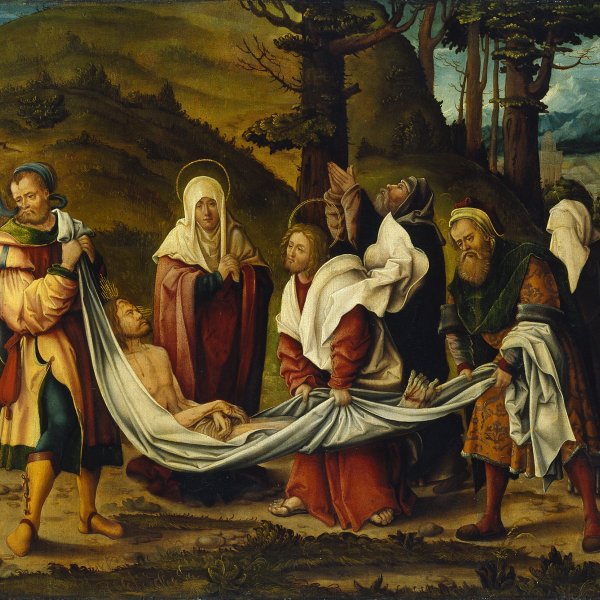Portrait of a young Woman
ca. 1522
Oil on panel.
59 x 45 cm
Museo Nacional Thyssen-Bornemisza, Madrid
Inv. no.
2
(1929.11
)
ROOM 9
Level 2
Permanent Collection
Renaissance and also one of the most important members of the Danube School. This group of artists, which included Lucas Cranach and Wolf Huber, placed particular emphasis on landscape in their compositions, imbuing it with emotional effects. Almost nothing is known of Altdorfer’s early years, including where he was born and any facts regarding his early training. It has been suggested that he initially trained as a miniaturist as his first known works, which are prints, reveal a knowledge of that technique and an interest in detail. Another unresolved issue is how he acquired his knowledge of the Italian Renaissance. The first documentary reference to the painter dates from 1505 in Ratisbon when he acquired citizenship, while the following one is from 1513 when he acquired a house. Altdorfer combined his artistic career with posts in the City Council for which he was municipal architect in 1526, a situation reflected in his relatively elevated social status. The artist painted one of the greatest works of western art, Alexander’s Victory at Issus, now in the Alte Pinakothek in Munich.
The attribution of the present portrait to Altdorfer was made by Friedländer, who dated it to around 1520.While the attribution has not been questioned the date has been the subject of debate and other authors have placed it between 1515 and 1525. The painting was acquired for the Collection the year after Friedländer's report written for the Hugo Perls gallery in Berlin. According to Christian Salm, the panel entered the Collection from a private German collection. It has been included in all the Collection’s catalogues since 1930.
Along with issues of dating, experts have also focused on the identity of the sitter. Two suggestions have been made but both have been rejected on grounds of insufficient proof. The first proposed that the panel depicts the painter’s wife from the tender expression and from the fact that it is the only known female portrait by Altdorfer. This romantic and sentimental suggestion was followed by another one, which proposed that it depicted Barbara Blomberg, mother of Don Juan of Austria and lover of Charles V during the Imperial Diet at Ratisbon. This idea is difficult to accept given the fact that Barbara was born in 1527 and the fact that Altdorfer died in 1538. The idea derives from a commentary written by Ralf von Retberg in 1846 in which he mentioned a portrait of Babara Blomberg painted by Altdorfer in 1522 in the Kränner collection in Ratisbon.
The panel depicts the only known individual female portrait so far attributed to Altdorfer. The painter focused on religious, mythological and allegorical subjects and produced few portraits. The young woman stands full-length against a green backgroundthat has been interpreted as a landscape or as velvet. All the light is focused on her figure and is absorbed by the light tones of her headdress, blouse and sleeves. It is also reflected in the shot colours of her bodice, creating orange, pink and green tones of the highest quality. The face, which has features characteristic of Altdorfer’s style, is finely constructed and conveys a sense of tranquillity despite the asymmetry of the mouth. This oil, which is unique within Altdorfer’s oeuvre, has been compared from the point of view of its date to The Birth of the Virgin in the Alte Pinakothek in Munich.
Mar Borobia
The attribution of the present portrait to Altdorfer was made by Friedländer, who dated it to around 1520.While the attribution has not been questioned the date has been the subject of debate and other authors have placed it between 1515 and 1525. The painting was acquired for the Collection the year after Friedländer's report written for the Hugo Perls gallery in Berlin. According to Christian Salm, the panel entered the Collection from a private German collection. It has been included in all the Collection’s catalogues since 1930.
Along with issues of dating, experts have also focused on the identity of the sitter. Two suggestions have been made but both have been rejected on grounds of insufficient proof. The first proposed that the panel depicts the painter’s wife from the tender expression and from the fact that it is the only known female portrait by Altdorfer. This romantic and sentimental suggestion was followed by another one, which proposed that it depicted Barbara Blomberg, mother of Don Juan of Austria and lover of Charles V during the Imperial Diet at Ratisbon. This idea is difficult to accept given the fact that Barbara was born in 1527 and the fact that Altdorfer died in 1538. The idea derives from a commentary written by Ralf von Retberg in 1846 in which he mentioned a portrait of Babara Blomberg painted by Altdorfer in 1522 in the Kränner collection in Ratisbon.
The panel depicts the only known individual female portrait so far attributed to Altdorfer. The painter focused on religious, mythological and allegorical subjects and produced few portraits. The young woman stands full-length against a green backgroundthat has been interpreted as a landscape or as velvet. All the light is focused on her figure and is absorbed by the light tones of her headdress, blouse and sleeves. It is also reflected in the shot colours of her bodice, creating orange, pink and green tones of the highest quality. The face, which has features characteristic of Altdorfer’s style, is finely constructed and conveys a sense of tranquillity despite the asymmetry of the mouth. This oil, which is unique within Altdorfer’s oeuvre, has been compared from the point of view of its date to The Birth of the Virgin in the Alte Pinakothek in Munich.
Mar Borobia









